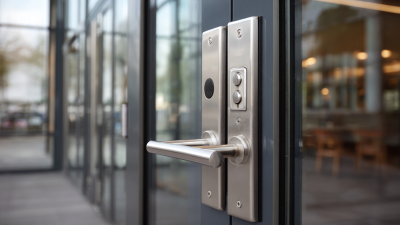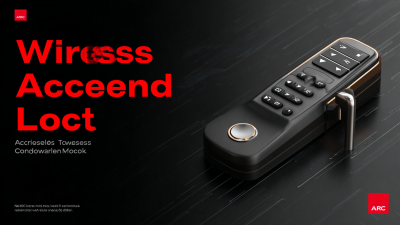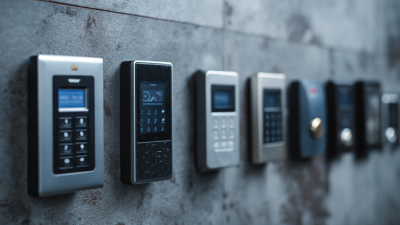How to Choose the Best Door Entry Systems for Home Security
In today's world, home security has become a paramount concern for homeowners, with reports indicating that homes without a security system are 300% more likely to be broken into. As such, selecting the right Door Entry Systems is essential for safeguarding your residence. With advancements in technology, homeowners now have a plethora of options ranging from traditional locks to smart entry systems that can be controlled remotely.
According to a recent industry study by the Security Industry Association, the market for smart door locks is expected to grow significantly, projected to reach $1.5 billion by 2025. This emphasizes the need for homeowners to make informed decisions about which Door Entry Systems not only enhance security but also offer convenience and peace of mind. In this guide, we will explore the best practices for choosing the most effective door entry solutions tailored to your specific security needs.
Understanding Different Types of Door Entry Systems for Enhanced Home Security
When considering enhanced home security, understanding the various types of door entry systems available is crucial. Research from the Security Industry Association indicates that approximately 40% of break-ins occur through the front door, highlighting the need for effective entry solutions. Traditional keyed locks are being phased out in favor of more advanced alternatives such as keyless entry systems and smart locks, which not only offer security benefits but also convenience.
Keyless entry systems, which can utilize codes, biometrics, or mobile app controls, provide an added layer of security by eliminating the risk of lost keys. According to a report by the Electronic Security Association, homes equipped with smart locks can decrease the likelihood of a burglary by nearly 50%. Additionally, video doorbells are gaining popularity, allowing homeowners to monitor their entries remotely. With the combined use of these modern door entry systems, homeowners can significantly enhance their security while enjoying the convenience of technology in their daily lives.

Evaluating Features of Keyless Entry Systems: Convenience vs. Security
When choosing a door entry system for home security, it's essential to balance convenience and security, particularly with keyless entry systems. These systems are gaining popularity due to their ease of use; for instance, a 2022 study by the Security Industry Association reported that 75% of homeowners prioritize convenience in their security solutions. Keyless entry allows for easy access without the need for traditional keys, which can be lost or duplicated. However, this convenience can come at a price, as studies show that homes with keyless entry systems can be more vulnerable if not properly secured.
Evaluating the features of keyless systems is crucial to ensuring robust security. According to a recent report from the Electronic Security Association, 40% of keyless entry systems are compromised through hacking or security breaches when weak password practices are employed. Homeowners should consider systems with advanced security features like two-factor authentication, biometric options, and robust encryption protocols. These enhancements not only bolster security but also provide peace of mind, ensuring that the convenience of accessing your home does not compromise its safety.
Assessing the Role of Video Doorbells in Deterring Intruders and Monitoring
Video doorbells have emerged as a vital component in home security systems, playing a significant role in deterring intruders and providing homeowners with peace of mind. According to a report by the Electronic Security Association, homes equipped with video doorbells can experience a reduction in burglaries by up to 50%. The presence of a visible camera appears to dissuade potential intruders, as they are aware they are being monitored and recorded. Moreover, these devices allow homeowners to interact with visitors remotely, enhancing the feeling of security even when they are not at home.
Additionally, video doorbells contribute to continuous monitoring of the home environment. A study from the Security Industry Association highlighted that video footage can serve as crucial evidence in legal situations. Having recorded visuals can aid law enforcement in investigating crimes more effectively. Furthermore, many modern video doorbells come equipped with motion detection alerts, enabling homeowners to receive real-time notifications of any activity outside their door. This proactive approach to home monitoring provides an invaluable layer of security, reinforcing the importance of integrating video doorbells into a comprehensive home security system.
How Video Doorbells Enhance Home Security
Comparing Smart Locks with Traditional Locks: Security Levels and Vulnerabilities
When selecting door entry systems for home security, it's essential to compare smart locks and traditional locks, focusing on their respective security levels and vulnerabilities. Traditional locks, while reliable, can fall victim to physical attacks such as picking or bumping. As many homeowners are aware, the efficacy of traditional locks largely depends on their construction quality and the skills of potential intruders. Recent market analyses indicate that the global smart lock market, valued at approximately $17.5 billion in 2023, is projected to grow at a compound annual growth rate of over 12.7% from 2024 to 2032. This growth reflects the increasing reliance on smartphones and digital technology in our daily lives.

In contrast, smart locks leverage advanced technologies that can enhance security through features like biometric access, remote operation, and real-time monitoring. However, they are not without vulnerabilities. With the rise of quantum computing, the conventional encryption methods that protect smart locks can be compromised in the future. For instance, a recent announcement highlighted a company's release of the world's first quantum-resistant security hardware, marking a critical advancement in the fight against emerging threats. As the home security landscape evolves, homeowners must consider not only the convenience provided by smart locks but also the importance of integrating robust security measures to protect against both physical and cyber threats.
Statistics on Home Break-Ins: Why Effective Entry Systems Matter for Homeowners
Home break-ins are a pressing concern for many homeowners, with statistics revealing alarming trends. According to recent data, a burglary occurs approximately every 30 seconds in the United States. Understanding the nature of these incidents reveals that most break-ins happen during daylight hours, often when residents are at work or school. This unpredictability underscores the necessity of robust entry systems to deter potential intruders.
Effective door entry systems play a crucial role in enhancing home security. Options range from traditional deadbolts to advanced smart locks that offer remote monitoring and control. A significant 60% of burglars indicate that they would avoid a targeted home if they noticed security features, such as high-end locking mechanisms or surveillance cameras. Investing in a comprehensive entry system not only protects physical property but also provides peace of mind, knowing that proactive measures have been taken against the rising tide of home invasions.









